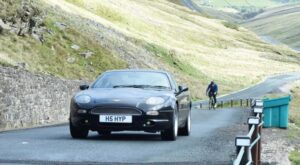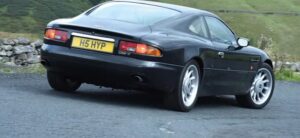Advertisement
Aston Martin DB7

Deciding which is the best road in the UK is a highly subjective matter. Some say it’s the A272 through the South Downs, while others say it’s Cheddar Gorge in Somerset. For a minority, it is any street with a pub at the end.
For me, it has to be Buttertubs Pass in the heart of the Yorkshire Dales. A seven-mile strip of asphalt that winds its way through some of the most beautiful yet harshest scenery in the country, it’s a true test for any car. Thus, it’s the ideal place to put Prestige & Performance Car’s sister title to the test, the 1997 DB7 3.2 coupe from Aston Martin Driver Magazine.
Advertisement
Even getting there is an adventure. With the road connecting the isolated villages of Simonstone and Muker, there is no easy or direct route and whichever direction you take passes through some of the emptiest and most desolate fields in England. If it breaks down here, it will be weeks before help arrives, but sadly, that’s a real possibility with this car.
A 25-year-old DB7 coupe with 93,500 miles on the clock, it is in reasonably good physical condition with only a few barely noticeable marks on the black bodywork, while the beautiful 12-spoke wheels are immaculate. The interior is clean and aside from the dead oil pressure gauge, which triggers a permanent oil warning light on the dash, everything works, although the driver’s side power window and central locking sometimes have a mind of their own.
As soon as the car passed into AMD ownership, respected DB7 expert KWE from Thatcham, near Reading, was dispatched to restore the supercharger as a new one is now hard to find. At the same time, the radial arms and bushings were also replaced and the location of a minor power steering fluid leak was identified and repaired.
Advertisement

Advertisement
After I collected the car from Kelsey Publishing head office in Kent a few weeks later, the engine died while on the M11 and would not start again. The AA patrolman soon diagnosed a faulty alternator, swapping the now dead battery for one with power, allowing me to finish my ride. Although there were problems getting a replacement, my local shop eventually installed a new alternator.
And finally, on my way home from Yorkshire after the photo shoot for this feature, the engine stalled once more, this time on the A1 (M1) near the junction with the M62. Because I’m surrounded by fast highways, aside from a safari park’s lion enclosure, I can’t think of a more dangerous place to break. Fortunately, the car and I were soon recovered to the safety of a nearby service, although it took another four hours to be collected and transported home. But when the car was delivered to Express Autocare the next day, the technician quickly discovered that the crankshaft position sensor had simply popped. It is unknown why this happened; I’m hoping it just wasn’t positioned correctly and isn’t a sign of a bigger problem.
Advertisement
Despite the problems though, I still love the car. How could she not when she looks so good? Arguably one of the most beautiful coupes of the last 30 years, its smooth, curvaceous yet classic design hasn’t gone as out of style as others of the time, including, in my opinion, the more angular BMW 8 Series. However, the DB7 is also relatively roomy for a low-slung sports car, offering a perfect driving position, while the leather-trimmed seats are large and supportive.
Although, even when new, the 3.2-litre supercharged straight-six was never the most refined of engines (it’s a vintage Jaguar unit from the 1980s, after all), the car still drives effortlessly. At 70 mph on the highway with plenty of torque available for sudden shifts. overtaking.
The one area that has never impressed me with the DB7 is its interior. Not the design; Simple, it’s relatively easy to use, though it’s hard to operate the cruise control without looking down, since the buttons are awkwardly located in front of the armrest. What disgusts me most is the number of switches stolen from Ford parts bins for a car that in 1997 cost £82,500. I drove a 1991 Fiesta RS Turbo shortly before this feature and many of the controls on the DB7 appear to be identical.
Advertisement
Deciding which is the best road in the UK is a highly subjective matter. Some say it’s the A272 through the South Downs, while others say it’s Cheddar Gorge in Somerset. For a minority, it is any street with a pub at the end.
For me, it has to be Buttertubs Pass in the heart of the Yorkshire Dales. A seven-mile strip of asphalt that winds its way through some of the most beautiful yet harshest scenery in the country, it’s a true test for any car. Thus, it’s the ideal place to put Prestige & Performance Car’s sister title to the test, the 1997 DB7 3.2 coupe from Aston Martin Driver Magazine.
After leaving the A1(M) at Scotch Corner and then navigating the quiet Yorkshire roads, I finally arrive at Simonstone, a town so small it makes Brigadoon look positively cosmopolitan by comparison. Soon I’m on Cliff Gate Road, more commonly known as Buttertubs Pass and with the view before me emptier than the Russian tundra, I hit the throttle hard, waking up the supercharger for a sudden burst of acceleration. Although the DB7 isn’t fast by today’s standards – officially hitting 60mph in 5.8 seconds when equipped with an automatic gearbox like this – acceleration still feels crisp, the sensation heightened by the rising whine of the supercharger. Though sluggish from low gear, when on the move, the inline-six always feels revved up and eager, delivering relatively smooth, lag-free forward motion the moment I ask for it.
Advertisement
It is now when the road begins to climb; At 526 m (1,726 ft) above sea level, Buttertubs Pass is one of the highest roads in England and the steep grade is starting to stunt the car’s acceleration. Even though the engine makes a healthy 335bhp, I need to keep my foot down to retain any kind of momentum.
When the road finally levels out, I am surrounded in every direction by stunning views of the Wensleydale countryside. With its dramatic peaks and endless views, I start to feel like I’m in a scene from Game of Thrones or All Creatures Great and Small, which was filmed in the area but featured fewer dragons.
As the road begins to straighten out, I hit the throttle again, forcing the ever-slow and dumb four-speed automatic into full throttle. Even in the mid-1990s, when most other sports cars of the day were equipped with five-speed gearboxes, a four-speed unit was considered old-fashioned. The Jaguar XK8, for example, which arrived in 1996 and cost £34,500 less than the DB7, had an extra gear.
Advertisement
With a steel body and a weight of 1,750 kg, the DB7 is relatively heavy and therefore lacks the nimbleness and agility of the 993 generation Porsche 911 or the later Aston Martin V8 Vantage. Grip is always great though, while the precise and precise steering allows me to quickly navigate a fast S-bend, the car only suffers from minor body roll.
However, based on the same chassis as one of the world’s smoothest-handling coupes, the Jaguar XJ-S, the DB7’s ride is also excellent. The familiar double wishbone Jaguar-style suspension setup at the front with a lower wishbone and driveshafts acting as upper arms at the rear perfectly absorbs the worst surfaces this isolated road has to offer.
After running over the top, the howl of the supercharger no doubt mistook it for an approaching Exocet missile, the road begins to descend and it’s somewhere around here that Buttertubs Pass gets its name. Nearby are 20m deep holes in the limestone where farmers would apparently drop the butter they had produced to keep it fresh while resting on their way to market. So perhaps a better name would be Big Fridge Pass.
Advertisement
As the path drops even lower, to my right is a plummeting drop that has only the thinnest of steel cables to keep me from falling over the edge. One wrong move here and it wouldn’t be an anti-aircraft truck you’d need to recover, but a helicopter.
Fear of death aside, the scenery on this side of the pass is just as spectacular, the endless rolling hills of Swaledale filling the screen. But due to a hairpin that is similar in shape to the Monaco Grand Prix circuit but with more sheep, I don’t have time to enjoy them. Once again, the precise steering allows me to zip through the tight bend before hitting the throttle hard on a long, flowing straight that ends too soon at a T-junction. After turning right, I drive slowly towards Muker, another Pretty little town that gets its unusual name from the Old Norse for ‘the narrow newly cultivated field’. You can say what you want about the Norse, but they were literal when it came to their place names.
Although Buttertubs Pass is only seven miles long, it’s still an exhilarating ride, offering similar challenges to a race course, but all the adventure of a hike up the Duke of Edinburgh’s Prize Hills. It has also been the perfect place to test our new purchase. Although it is far from perfect (two breakdowns in less than a month prove it), the road has shown that it is a fast, comfortable and pleasant car.
Advertisement
So while it’s anyone’s guess which is the best road for drivers in the UK, when it comes to the best sports coupe of the ’90s, there’s clearly no arguing.View More……..


